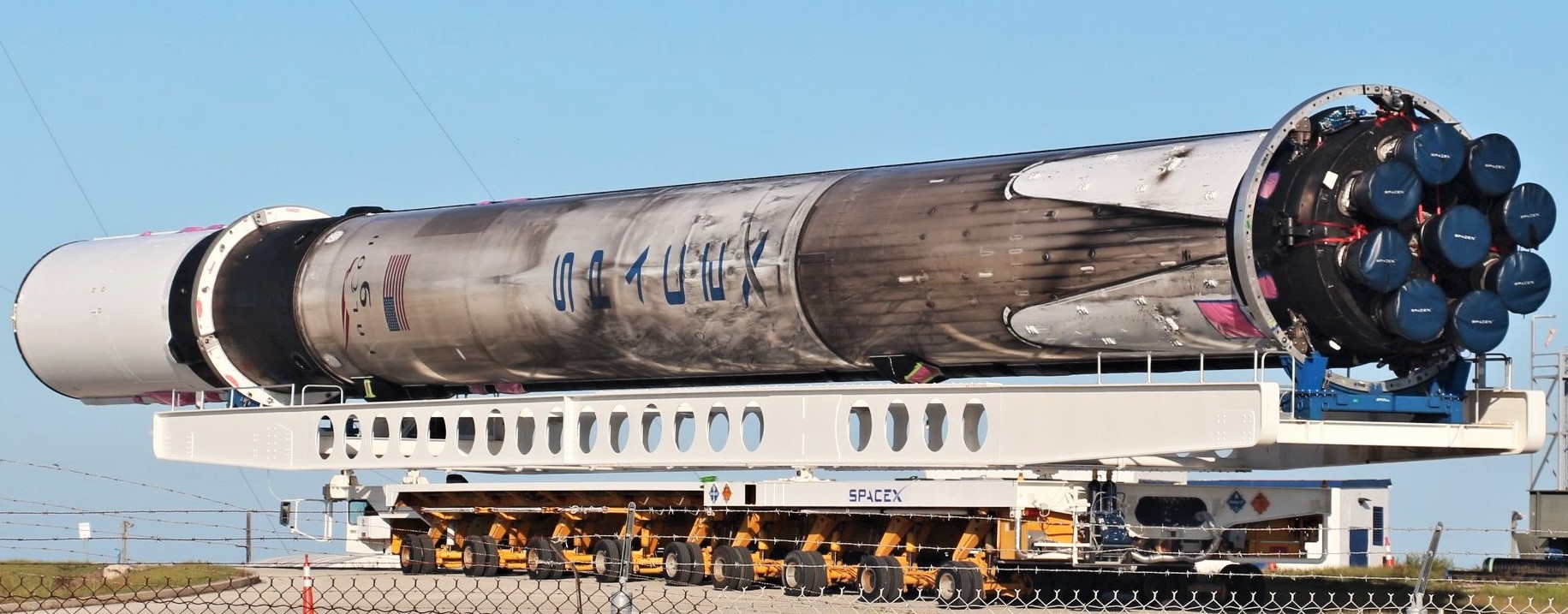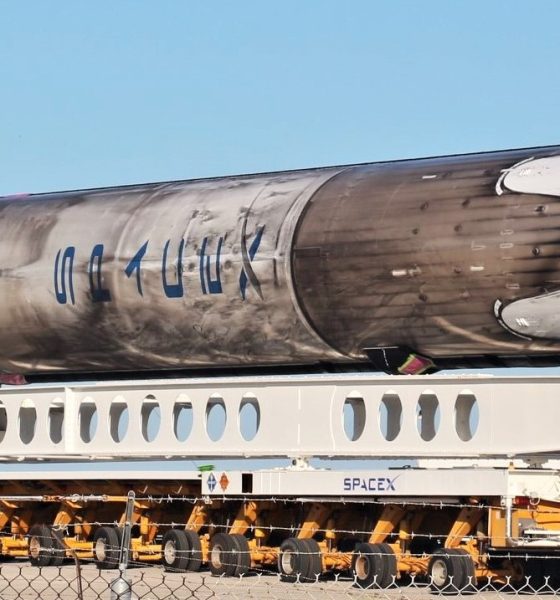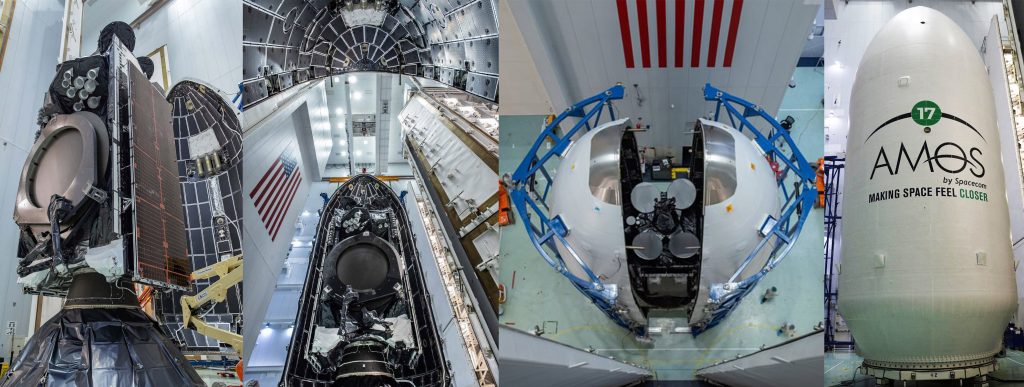

News
SpaceX transports Falcon 9 to launch site ahead of Block 5’s second expendable launch ever
Photos published on July 28th by customer Spacecom show a sooty SpaceX Falcon 9 booster and fresh upper stage on their way to LC-40 for the launch of the AMOS-17 communications satellite, scheduled to lift off no earlier than 6:51 pm EDT (22:51 UTC), August 3rd.
Sadly, the booster will reportedly be expended during the launch. According to Spacecom, AMOS-17 – built by Boeing – is an undeniably large satellite, weighing more than 6500 kg (14,300 lb) and featuring a solar array wingspan of ~35m (115 ft). SpaceX has certainly launched larger satellites than AMOS-17 and still recovered their Falcon 9 boosters, but this mission is somewhat unique and SpaceX is obviously willing to go the extra mile in this case.
In a surprise development, Spacecom officially confirmed that AMOS-17 will be SpaceX’s second expendable Falcon 9 Block 5 launch in the rocket’s ~15 months of operations, following in the footsteps of its expendable December 2018 launch debut. This is more than a little disappointing, thanks in large part to the fact that SpaceX has developed Falcon 9 (and Heavy) reusability to such a level of maturity that fully expendable Falcon launches just feel wrong.
In fact, just a month ago, SpaceX reached a major milestone of reusability when it recovered two flight-proven Falcon Heavy boosters and became the first company in history to launch and land more orbital-class rocket boosters than it has expended (as of June 2019: 81 launched, 43 landed). SpaceX followed this up with landing #44 after Falcon 9 B1056.2 successfully completed its second launch on July 25th.
While expending a Block 5 booster that SpaceX CEO Elon Musk has stated could launch upwards of 20-30 times is certainly disappointing, the sting of Block 5’s second expendable mission is at least soothed by the knowledge that it will be this booster’s third and final launch. The first expendable Block 5 launch – the US Air Force’s GPS III SV01 mission – made use of a brand new booster (B1054).
A (hopefully) worthy sacrifice
In a small way, Falcon 9 B1047’s premature demise could easily be viewed as a sort of symbolic eye-for-an-eye sacrifice. Although not a literal 1:1 replacement, AMOS-17 is still essentially a follow-on to Amos-6, destroyed on September 1st, 2016 when Falcon 9 suffered an exotic COPV failure that led to a massive explosion (Musk called it a ‘fast fire’).
Installed on top of the rocket during what was meant to be a pre-launch static fire test, the ~$200M+ Amos-6 satellite was not spared from the destruction and owner Spacecom ultimately received an insurance settlement it then used (in part) to purchase AMOS-17. Additionally, instead of accepting a cash payout from SpaceX, Spacecom chose the contractual alternative: a free Falcon 9 launch of their choice.
Is it a coincidence that a Block 5 booster is going to be expended as part of that replacement launch? Almost certainly, yes. At a minimum, SpaceX – essentially launching for free per a contractual agreement with Spacecom – has clearly decided along with Spacecom that putting all of Falcon 9’s energy into AMOS-17 is preferable to withholding margin for a landing.

With Falcon 9 B1047.2 in an expendable configuration, SpaceX can take a no-holds-barred approach towards delivering Spacecom’s AMOS-17 to the highest orbit possible. The higher the geostationary transfer orbit (GTO) Falcon 9 can launch AMOS-17 to, the faster the satellite can begin serving customers and thus generating revenue for Spacecom. Combined with the fact that more than half of AMOS-17’s massive 6.5-ton mass is chemical propellant, the spacecraft – pending a healthy launch and on-orbit commissioning – could be ready to start serving customers just a month or two after lift-off.
Falcon 9 B1047 will be missed, but the booster’s demise is an understandable cost of SpaceX prioritizing customer Spacecom’s launch experience above the company’s own best interests.
Check out Teslarati’s Marketplace! We offer Tesla accessories, including for the Tesla Cybertruck and Tesla Model 3.

Elon Musk
Elon Musk and Tesla AI Director share insights after empty driver seat Robotaxi rides
The executives’ unoccupied tests hint at the rapid progress of Tesla’s unsupervised Robotaxi efforts.

Tesla CEO Elon Musk and AI Director Ashok Elluswamy celebrated Christmas Eve by sharing personal experiences with Robotaxi vehicles that had no safety monitor or occupant in the driver’s seat. Musk described the system’s “perfect driving” around Austin, while Elluswamy posted video from the back seat, calling it “an amazing experience.”
The executives’ unoccupied tests hint at the rapid progress of Tesla’s unsupervised Robotaxi efforts.
Elon and Ashok’s firsthand Robotaxi insights
Prior to Musk and the Tesla AI Director’s posts, sightings of unmanned Teslas navigating public roads were widely shared on social media. One such vehicle was spotted in Austin, Texas, which Elon Musk acknowleged by stating that “Testing is underway with no occupants in the car.”
Based on his Christmas Eve post, Musk seemed to have tested an unmanned Tesla himself. “A Tesla with no safety monitor in the car and me sitting in the passenger seat took me all around Austin on Sunday with perfect driving,” Musk wrote in his post.
Elluswamy responded with a 2-minute video showing himself in the rear of an unmanned Tesla. The video featured the vehicle’s empty front seats, as well as its smooth handling through real-world traffic. He captioned his video with the words, “It’s an amazing experience!”
Towards Unsupervised operations
During an xAI Hackathon earlier this month, Elon Musk mentioned that Tesla owed be removing Safety Monitors from its Robotaxis in Austin in just three weeks. “Unsupervised is pretty much solved at this point. So there will be Tesla Robotaxis operating in Austin with no one in them. Not even anyone in the passenger seat in about three weeks,” he said. Musk echoed similar estimates at the 2025 Annual Shareholder Meeting and the Q3 2025 earnings call.
Considering the insights that were posted Musk and Elluswamy, it does appear that Tesla is working hard towards operating its Robotaxis with no safety monitors. This is quite impressive considering that the service was launched just earlier this year.
Elon Musk
Starlink passes 9 million active customers just weeks after hitting 8 million
The milestone highlights the accelerating growth of Starlink, which has now been adding over 20,000 new users per day.

SpaceX’s Starlink satellite internet service has continued its rapid global expansion, surpassing 9 million active customers just weeks after crossing the 8 million mark.
The milestone highlights the accelerating growth of Starlink, which has now been adding over 20,000 new users per day.
9 million customers
In a post on X, SpaceX stated that Starlink now serves over 9 million active users across 155 countries, territories, and markets. The company reached 8 million customers in early November, meaning it added roughly 1 million subscribers in under seven weeks, or about 21,275 new users on average per day.
“Starlink is connecting more than 9M active customers with high-speed internet across 155 countries, territories, and many other markets,” Starlink wrote in a post on its official X account. SpaceX President Gwynne Shotwell also celebrated the milestone on X. “A huge thank you to all of our customers and congrats to the Starlink team for such an incredible product,” she wrote.
That growth rate reflects both rising demand for broadband in underserved regions and Starlink’s expanding satellite constellation, which now includes more than 9,000 low-Earth-orbit satellites designed to deliver high-speed, low-latency internet worldwide.
Starlink’s momentum
Starlink’s momentum has been building up. SpaceX reported 4.6 million Starlink customers in December 2024, followed by 7 million by August 2025, and 8 million customers in November. Independent data also suggests Starlink usage is rising sharply, with Cloudflare reporting that global web traffic from Starlink users more than doubled in 2025, as noted in an Insider report.
Starlink’s momentum is increasingly tied to SpaceX’s broader financial outlook. Elon Musk has said the satellite network is “by far” the company’s largest revenue driver, and reports suggest SpaceX may be positioning itself for an initial public offering as soon as next year, with valuations estimated as high as $1.5 trillion. Musk has also suggested in the past that Starlink could have its own IPO in the future.
News
NVIDIA Director of Robotics: Tesla FSD v14 is the first AI to pass the “Physical Turing Test”
After testing FSD v14, Fan stated that his experience with FSD felt magical at first, but it soon started to feel like a routine.

NVIDIA Director of Robotics Jim Fan has praised Tesla’s Full Self-Driving (Supervised) v14 as the first AI to pass what he described as a “Physical Turing Test.”
After testing FSD v14, Fan stated that his experience with FSD felt magical at first, but it soon started to feel like a routine. And just like smartphones today, removing it now would “actively hurt.”
Jim Fan’s hands-on FSD v14 impressions
Fan, a leading researcher in embodied AI who is currently solving Physical AI at NVIDIA and spearheading the company’s Project GR00T initiative, noted that he actually was late to the Tesla game. He was, however, one of the first to try out FSD v14.
“I was very late to own a Tesla but among the earliest to try out FSD v14. It’s perhaps the first time I experience an AI that passes the Physical Turing Test: after a long day at work, you press a button, lay back, and couldn’t tell if a neural net or a human drove you home,” Fan wrote in a post on X.
Fan added: “Despite knowing exactly how robot learning works, I still find it magical watching the steering wheel turn by itself. First it feels surreal, next it becomes routine. Then, like the smartphone, taking it away actively hurts. This is how humanity gets rewired and glued to god-like technologies.”
The Physical Turing Test
The original Turing Test was conceived by Alan Turing in 1950, and it was aimed at determining if a machine could exhibit behavior that is equivalent to or indistinguishable from a human. By focusing on text-based conversations, the original Turing Test set a high bar for natural language processing and machine learning.
This test has been passed by today’s large language models. However, the capability to converse in a humanlike manner is a completely different challenge from performing real-world problem-solving or physical interactions. Thus, Fan introduced the Physical Turing Test, which challenges AI systems to demonstrate intelligence through physical actions.
Based on Fan’s comments, Tesla has demonstrated these intelligent physical actions with FSD v14. Elon Musk agreed with the NVIDIA executive, stating in a post on X that with FSD v14, “you can sense the sentience maturing.” Musk also praised Tesla AI, calling it the best “real-world AI” today.








